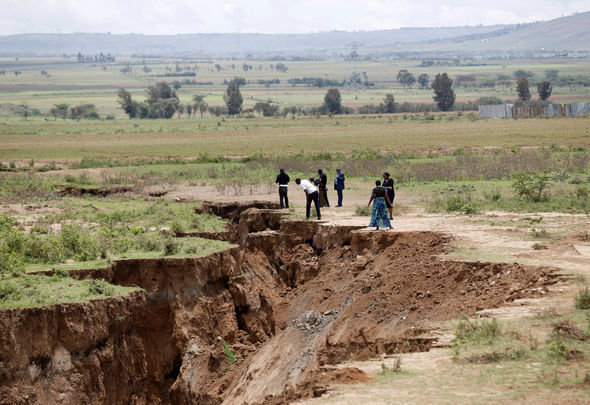
A large crack, stretching several kilometers, made a sudden appearance recently in south-western Kenya. The tear, which continues to grow, caused part of the Nairobi-Narok highway to collapse and was accompanied by seismic activity in the area.
The large, deep split occurred this week at Kenya’s Rift Valley and was thought to have been caused by a heavy downpour above an underground fault line.
The fissures tore apart a busy road and the government has had to intervene, desperately trying to fill the chasm with rocks and cement.
The house of a 72-year-old woman was even reported to have been split down the middle as she sat eating with her family.
Eliud Njoroge and his wife said their home was also ripped apart in the village of Mai Mahiu and was eventually destroyed.
And experts say it is evidence that the Somali tectonic plate, which runs from Mozambique to the Horn of Africa, is separating from the Nubian Plate.
Geologist David Ahede told the Daily Nation: “The Great Rift splits Africa into two plates.
“With what is happening we have established one plate which is the Somali plate is moving away from the other plate at a rate of 2.5cm.
“In the near future if this happens we shall have the Somali plate separating from the other Nubian plate.
“You cannot stop a geological process because it occurs from deep within the crust of the Earth.”
But experts say the gradual splitting of the continent will not be over for millions of years.
Writing for The Conversation, Lucia Perez Diaz, postdoctoral researcher at the Fault Dynamics Research Group at London’s Royal Holloway University, said the phenomenon came from the thinning of the lithosphere – a term for the crust and upper part of the Earth’s mantle.
She wrote: “In this area, the lithosphere has thinned almost to the point of complete break up.
“When this happens, a new ocean will begin forming by the solidification of magma in the space created by the broken-up plates.
“Eventually, over a period of tens of millions of years, seafloor spreading will progress along the entire length of the rift.
“The ocean will flood in and, as a result, the African continent will become smaller and there will be a large island in the Indian Ocean composed of parts of Ethiopia and Somalia, including the Horn of Africa.”
In the meantime, geologists have warned that authorities need to do more to take fault lines into account as they plan their new roads, rail lines and infrastructure projects.













